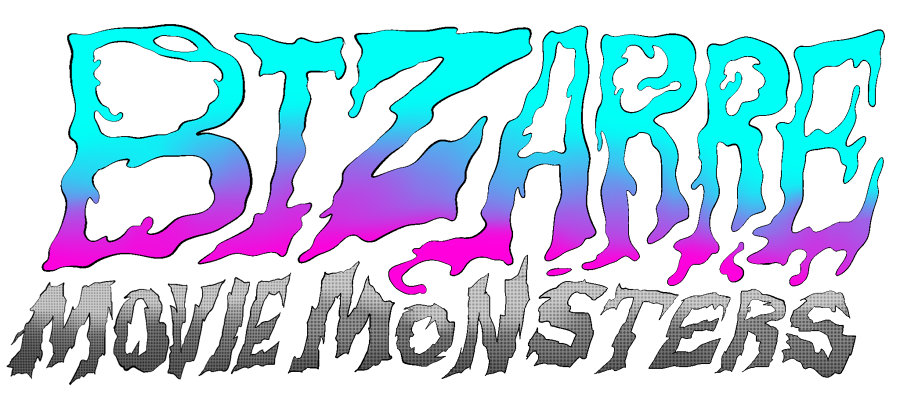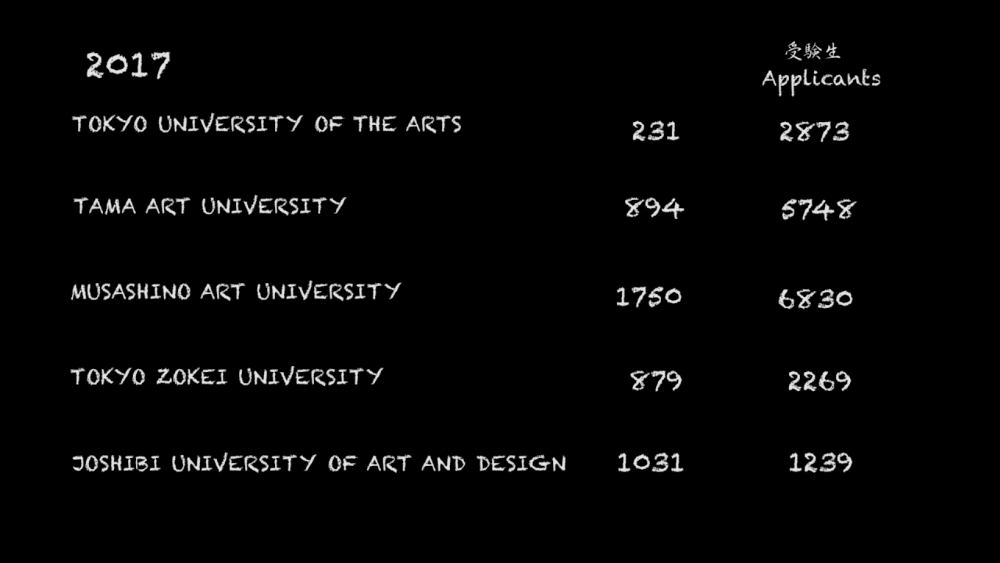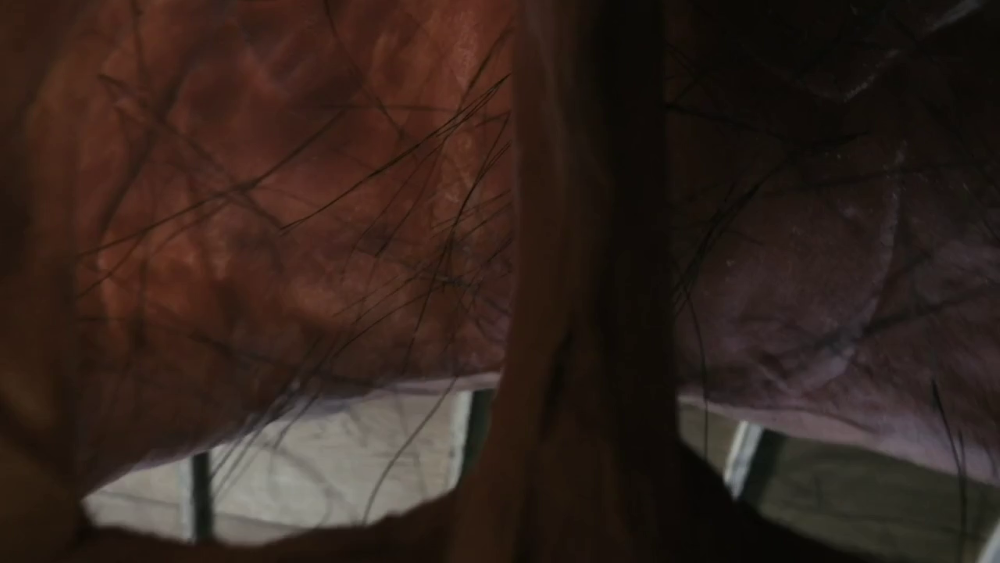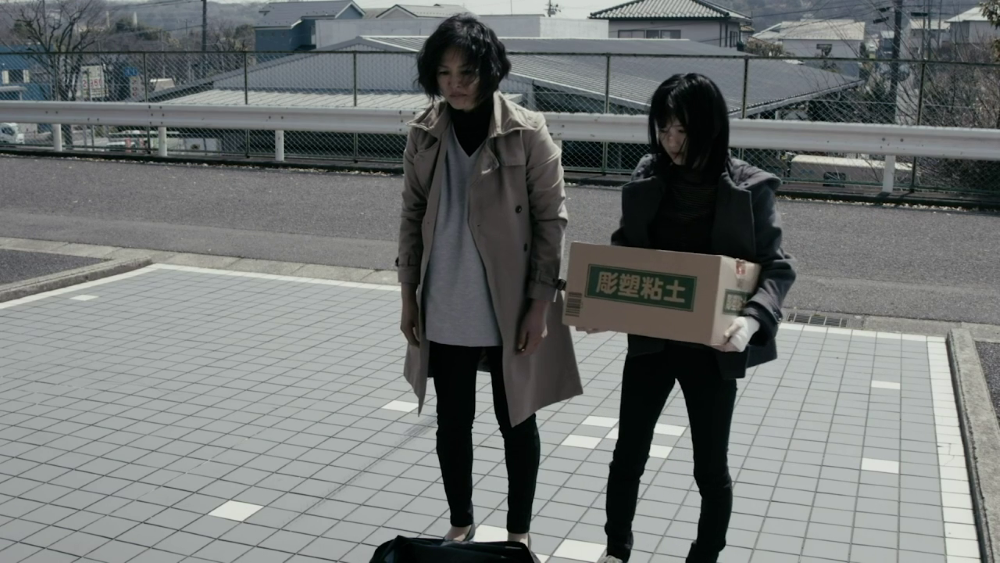
By Jonathan Wojcik
ENTRY 34: VAMPIRE CLAY
(LEGALLY FREE TO WATCH HERE!)

Oh my god, what happened?! Over a whole year since I promised to write another of these monthly, and I guess it's a rhetorical question because I do know what happened, which was that my
Mortasheen project needed a hundred times more attention.
But I'm back at this, at least for now, to talk about one of my new all-time favorite monster movies since I began this review series.
Vampire Clay was directed by Soichi Umezawa and released in 2017, somehow completely slipping my notice until 2023. It's one of those movies marketed as absurdist "you-gotta-see-this!" schlock, but as is quite often the case, it's a sincere and successful effort at a fun, creative tale of the bizarre, dripping with love for the production and especially backed by a
great soundtrack, which we'll be talking about shortly.



Vampire Clay (or literally just "blood-sucking clay" in Japanese) rather interestingly opens with some real-world statistics about the state of art education in Japan, comparing the thousands of hopeful applicants to the relatively pitiful acceptance rate. This sets the perfect stage for our opening scene, in which art teacher Yuri Aina (Asuka Kurosawa) arrives at a neglected, dilapidated studio where she'll be teaching a meager class of six students...and where she finds a seemingly untouched block of high-quality clay mysteriously buried in the front yard.

Yuri is a harsh instructor. She's short-tempered, highly critical, and reeks of bitterness towards her own students, tearing into them for the lack of personal flair or imagination in their sculptures - particularly the busts of their own faces, which she'd hoped they would interpret more creatively than 1:1 realism.
Fair. It's the same thing I'd look for in a student if I were an art teacher! I don't think I'd be so mean about it, but she still has her reasons. We quickly gather that she once attended a more prestigious school with high hopes for her career, but
something happened to dash her aspirations.

It's only minutes into the film when we first see that mysterious block of clay stir to life, late at night, to extend a single tentacle and collect a
discarded razor blade, giving itself the physical means to draw blood and giving me a new permanent irrational fear of ever blindly sinking my hands into clay ever again.

Kaori (Kyoka Takeda) is the student we focus on most for the film, and the first one the clay gets a taste of, though she naturally assumes one of her fellow students must have hidden the blade in her clay as a cruel prank. That night, the hungry clay gets its first kill by devouring a pet hamster, and it only takes this single light appetizer to invigorate its enigmatic lifeforce.

Another student,
Reiko, comes in late that night to try and improve on her sculpture, but when she cuts herself on an uncovered screw, the clay wastes no time ambushing its first human victim, and even for this first attack sequence, its grotesque ingenuity is put on
full display:


Still shaped like her own face, the clay starts off by chomping down on Reiko's hand and chewing its way up her arm, until she manages to shake it off and hurl it across the room. Before she can run, it entangles her legs in a couple of clay tentacles, then creates an animate clay replica of the
hamster, which attempts to crawl into Reiko's mouth. She manages to spit it out and break free from the tentacles, but as she tries to call for help on her phone, she finds herself unable to dial with her
rapidly softening fingers, which is imagery I won't make you look at it, but you can
look at if you want to.


Reiko's new vampire-clay-hand turns on her by fusing to her
other hand, and she tries desperately to separate them again by wacking them on the edge of a table, but the clay breaks apart unevenly, leaving her with an amputated left arm and too-long right arm.
God. No wonder she just sort of stops and stands there for a while, as though her mind is struggling to catch up with everything that's just happened.



...And then, the malformed clay appendage morphs into a crude lump of a "head" with a giant, gaping mouth, just a little bit
Eraserhead. Reiko is completely swallowed by her own arm, encasing her in an unbaked pottery cocoon to complete her assimilation. All this has happened in the span of only a few minutes, and the film still isn't done with its first human kill.

The next day, Reiko seems to be mysteriously absent from class...but Kaori finds her own sculpture damaged, and everyone deduces that Reiko must have sabotaged it. Reiko's bust, on the other hand, is right back where she originally left it with nary a tentacle in sight, so Kaori decides to use it as spare clay for herself.

This may be the most disturbing sequence in the film, as we see that Reiko's consciousness is now imprisoned in her own sculpture, and as the clay is mashed and mangled, she perceives herself as a fully flesh and blood head with all the agony that would entail. The scene is a rapid-fire montage of cuts between the clay being molded, Reiko's real face shrieking in pain, and a lifelike but distressingly soft, stretchy prop head getting torn apart; a prop head with a porous, spongy red interior for good measure. The shots are "blink and you miss it," but take less than a second to leave a sickly and haunting enough impression that I probably can't show any of them, even under a link. It would ruin the effect anyway.



The horrendous torture appears to be the final end of Reiko's mind, but it obviously doesn't harm the clay, most of which has evidently already crawled off to construct a duplicate Reiko in the woods behind the studio. It's a flawless copy, visually, but the clay is'nt terribly bright, and doesn't seem to preserve much of the victim's memories or even a capacity for speech. The doppelganger attacks the first student it encounters, and in the ensuing struggle, part of its face is torn off. There appears to be smooth, featureless bone where an eye socket should be, but of course it's all clay, and the exposed clay "skull" forms a strange, beady, inhuman eye.

More mayhem (or perhaps CLAYhem!!!) ensues from there, until only three remain: Ms. Yuri, Kaori, and a girl named
Aiko, a less talented student who had some bonding moments with Kaori. Their battle with the clay deteriorates its disguise until its "true" form is revealed; a simple, stylized humanoid figure with an oversized head, a wide slotlike mouth and tiny, round holes for eyes. Just when our remaining heroines seem hopelessly cornered, however, a strange man bursts into the studio armed with the clay's only real weakness:
fire, of course!
We've actually seen this guy earlier, in brief. He's the one who originally buried the clay, he seems to be homeless or at least on the run, and he previously had to be chased off the property by Yuri. Who is he, really, and what was his connection to the clay?

The mystery hero recounts the story of a man named Mitazuka, who worked at a chemical plant during the day and on his artwork at night, repeatedly sculpting the same humanoid figure we've now already seen. His reclusive nature and terrible social skills had apparently ruined every chance he had at hitting it big, until an old college friend, Kyozo, came back into his life.

This friend had given up on his own art career to become a restaraunt owner, but thought Mitazuka's sculptures might catch on as restaurant decor, arranging a deal to do the marketing himself and share the profits. Mitazuka's health had been deteriorating rapidly, likely due to his job working around unspecified - perhaps even experimental? - toxic materials, and he eagerly agreed to one final chance at making any money. It seems at first as though his work still isn't selling well, but as his health takes a sharp downturn, Mitazuka incorporates his own blood into a final sculpture, which he names
Kakame.

Tragically, his sculptures
had in fact been popular, but Kyozo had been using most of the money to pay off a personal debt. When he finally comes clean, Mitazuka attacks him, and dies in the ensuing scuffle. The backstory does become a
little confusing here; we already saw him mix his blood into Kakame, and we also see Kakame pulsing as it's subsequently burned alongside its creator's corpse, but our narrator says that the artist's mysterious disease had "turned his bones to powder," and we see this powder stir to life when the grieving Kyozo spills his drink. So it was the blood mixed with the clay? The bones mixed with the clay? The blood
and the bones?
Whatever it was, Kyozo sees
something forming from the substance that terrifies him, just off-screen, until he burns it back into dust again, bags it up, and buries it in an abandoned lot, because I'm sure you already guessed he was the same person telling the tale.

Kyozo and the surviving women work together crushing, baking and sealing up the rest of the clay...or so they think. Some clay remains in another room, and shockingly, it's
Kaori who gets assimilated off-screen while cleaning up, nearly infecting Aiko before Kyozo manages to incinerate our former "main character." We soon cut to a now much larger collection of powdered vampire to dispose of, but unfortunately, the rapid-fire misfortunes aren't
nearly done.



Kyozo is just bagging up the dust when a
painting suddenly falls off the wall, and fans the powder directly into his face. We get a pretty oddball shot from inside his sinuses as the particles invade his body, kind of begging the question of how anybody avoided breathing any of it in before this point, but the details aren't important; what's important is that we watch the man's body hideously birth an entire new Kakame from his chest, which picks up a shard of pottery to wield as a knife.




The final battle, for real this time, sees Aiko using her own blood to catch the monster's attention, luring it into the path of a blowtorch that's unfortunately refusing to start up in time. But as the monster widens its maw and prepares to engulf her, Kyozo uses his last dying breath to stab it in the leg, distracting it even if the act doesn't technically do it any harm...right?
Well, Yuri takes that opportunity to impale Kakame on a metal bar, and with Aiko's help, goes to town bashing, tearing, stabbing and mangling the entity. We're treated to the movie's only "claymation" sequence as Kakame tries continuously to re-mold itself, while Ms. Yuri finally,
finally gets that torch to ignite.

Kakame is dead at last, roasted into what would be a
sick as hell light fixture in any tasteful home, but admittedly too dangerous to keep around.
What to do with it, then?



In the next scene, Yuri is standing just outside what we can deduce is the same art academy that had once dashed her own dreams, ready to donate a mystery box of free clay, at least until Aiko stops her teacher just in time, comforting her as she breaks down.

The two decide instead to seal the clay in multiple bags, in a plastic container, in a styrofoam cooler buried deep in the woods where, presumably, it will never be found again or at least not likely come into contact with human blood.
And it works! For months or perhaps even years, as we watch the days and seasons fly by...but we also see the roots of trees grow until they penetrate the container, we see
earthworms crawl inside, we see mud leaking into the cracks, and finally, we see the box completely unearthed once more by urban development.
This is the point at which many horror movies would roll the credits, leaving us to use our imaginations...but not
Vampire Clay. At least a few minutes remain in the film, and they're devoted to a final scene so wonderfully excessive, I IMPLORE you to watch the movie
for free on Tubi if you've liked anything you've seen so far. Maybe you feel like I've already spoiled everything there is to see, but we had to leave out a
lot of grotesque sequences, and I also can't stress enough how fun this one actually is to not only watch in its entirety, but to
hear!
For the rest of you,
absolutely certain you wouldn't rather just watch from beginning to end, enjoy this spoiler clip of approximately
half the finale scene, featuring some of that unique soundtrack I mentioned! What happens in the next half of this sequence?! We'll still leave that unspoiled. I will at least mention, the rest of the song has rapping in it. Did you expect "Vampire Clay" to have an original soundtrack of Japanese Swing Music Rap?? Is that the music you expected to accompany any part of what you're seeing here? Well...now it should be.
Forever.
MONSTER ANALYSIS (AND SPOILERS): KAKAME

How exactly
do we want to define this monster? Like John Carpenter's "The Thing," it's essentially more like an aggressive "cell line" than a single creature, a malevolent biomaterial that can limitlessly change its form, multiply itself and absorb other living things, driven only to keep feeding, growing and surviving. But we aren't left with only the question of
what this monster is; there's also the matter of
who it is.

We know the clay's unnatural life began with contamination by the diseased, toxic human blood of its own creator, who wishes for his creation to "see the world" in his place. Is this more of a biological mutation, a paranormal curse, or something in between? Kyozo addresses the clay on at least one occasion as though it's haunted by the soul of his deceased friend, but though we're certainly shown that human personalities may remain imprisoned in the clay, we never do see any sign of the original artist in its behavior, or even any particular reaction to Kyozo as its "killer."
If Mitazuka is anywhere in there, his personality has long degenerated to the state of a nearly mindless predator, and our only hint that the clay has any sort of personality is in the fact that it continues to recreate the original sculpture. There's no physical reason why the infinitely malleable entity should have to do so, which makes this more a matter of "self image." It remembers the form its creator
intended for it, and it places enough importance on this form to seemingly identify it as its "real" face.
What else might "Kakame" understand about its origins? It otherwise seems motivated only by blood, but does some part of it know that it's a piece of "artwork?" Does it at least dimly recall it was supposed to see the world, and be seen by the world as its father's dying wish? Would it have behaved any differently if Mitazuka hadn't died in rage, or was it always going to be a monster?

Kakame's basic design works perfectly; it feels as though it draws some inspiration from the works of
Izumi Kato (above), who also unwittingly inspired the entire
SCP Foundation, though Kakame is if anything a little less bizarre in appearance than Kato's embryonic figures. Its tiny eyes and muppet mouth are as charming as they are uncanny, resulting in a
believably eerie clay sculpture that doesn't ruin the mood with any more monster-movie ghoulishness than necessary, until of course it's actually forced to twist and warp its own proportions as it fights to feed and protect itself.

Then of course, there's that ending, which feels like a homage (or some would say ripoff?) of one especially famous Junji Ito scene. Just like Ito's
Tomie, the buried clay comes back to life with the body of a monstrous earthworm and multiple human faces, though in Kakame's case, it bears the faces of every past victim in the slimy hide of its hybrid earthworm-human-tree-clay body, and it's massive enough that the
very final shot of the film sees entire buildings collapsing to an unseen rampage; one also recalling some climactic moments from
Little Shop of Horrors.
Besides, perhaps, a bit of playful spite for the elitism of the art world, "Vampire Clay" isn't an especially deep movie with an especially complex antagonist, but it's a cool, creative, just plain
fun one. You feel that fun from its entire cast and direction, all the way down to the core idea of a monster movie about killer clay. It's a premise that inherently lends itself to nearly zero-budget visuals, and still the crew put extra effort into makeup, latex and puppetry effects to make their monster seem just a little more alive and organic than could be done with clay alone. They also could have gotten away with any generic, scary background music and still had a solid enough film, but the soundtrack showcases several all-original, lovably jazzy songs.
And there's still, perhaps,
one more layer to that monster as a character, if you delve just slightly deeper into the film's production and marketing. One last original song plays over the end credits, this one with a more mainstream Japanese pop-music sound to it; the kind of tune you hear in a lot of anime intros and outros.

This song also has an
official music video, interspersing moments from the film with some
interesting original imagery, which I personally choose to analyze here as an additional media appearance by the same monster. It's a song with a heartfelt, wistful, cautiously optimistic sort of mood, and begins from the perspective of one of the clay's victims, a girl who imagines herself trapped in a spherical cage (itself based on a popular art piece) as she works on a sculpture of herself.

...But soon, her sculpture grows on its own from a bust to a full body, and of course, her clay duplicate immediately kills her. Now, it's
the clay's song!

The clay pulls naught but a
clay electric guitar from the corpse of the original, and continues singing just a little off-key, with increasing intensity and emotion. The camera draws in closer. There's a flash of light.

...And suddenly, the doppelganger not only looks like full flesh and blood, playing a real instrument, but she's done up more glamorously than the human she replaced. She looks positively overjoyed, and even the lighting has become more vivid, more "alive" than it was for the original girl's scenes.

The last thing we see is that the cage is now empty. Of course, that girl is
dead...isn't she? Does a part of her live on, one with the consciousness of the clay, or is the clay simply acting on a fading, stolen memory of its last meal? Whatever the truth may be,
the cage is empty, and that appears to be something the song, now from our monster's perspective, is celebrating. Within the hypothetical extended canon we are extrapolating from this tie-in music video, the clay appears to perceive itself as an almost "liberated" continuation of the original human.
The cage, after all, is empty. Is that not a good thing!? Has the clay not ended this poor human's sadness???
....And the clay can SING!!! And the clay is
PRETTY!!!...and....and
HAPPY.......Like a HUMAN PERSON!!!.....YES!?!
LOOK, FATHER, YOUR KAKAME IS
LIVING!!! IT'S JUST LIKE YOU WANTED!!! YOUR CHILD IS TAKING ON THE WORLD!!!!!!
<3<3<3 aNd iT wiLL NeVeR sTtoP!!!!! <3<3<3 ^_____^














































